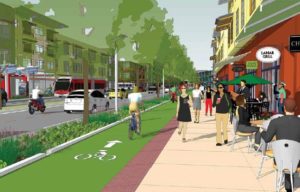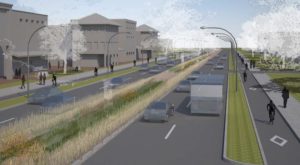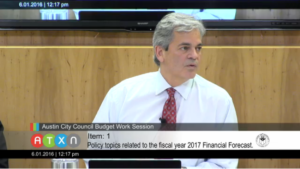Yesterday the Austin Transportation Department revealed the results of the Mobility Talks public survey and presented our options for a mobility bond in November.
We love Austin, but our traffic is among the worst in the country, and it’s getting harder and harder to be able to afford to live here. The Austin Transportation Department estimates that we have $9.5 billion in mobility needs. The good news is Senator Kirk Watson’s plan to partner with TxDOT to get I-35 done frees us up to use Austin’s bond capacity to make progress toward those mobility needs in a way that makes real progress on affordability. This is the moment for Austin to decide whether it’s serious about doing something about these problems in a new way. We know that addressing mobility on a project-by-project basis doesn’t produce the progress we need. Great cities do big things. Said another way, it’s time to go big or go home.
- Here’s what we’re already doing about traffic:
Our major highways in Austin are either undergoing major construction projects or studies to prepare for major construction to relieve traffic congestion. These projects include major work on MoPac and 183 that adds new managed lanes for express buses, Park & Rides at the perimeter of the city, and planning for the future of 620 and the Y at Oak Hill.
Senator Watson’s plan for I-35 – the most congested road in Texas – has Austin working with TxDOT, CAMPO, and our regional partners to fix it without a tax increase. The improvements also include managed lanes for express transit and lowering the lanes below ground level to make it possible to put a cap on it.
- Here’s what we have to do now about traffic congestion:
 We can make our roads work better by turning them into Smart Corridors. Our old state highways don’t work as major arteries. Starting with FM 969/East MLK, Jr. Boulevard, Airport Boulevard, and East Riverside Drive, North and South Lamar, Burnet Road, and the Drag on Guadalupe, we can turn them into Smart Corridors by adding:
We can make our roads work better by turning them into Smart Corridors. Our old state highways don’t work as major arteries. Starting with FM 969/East MLK, Jr. Boulevard, Airport Boulevard, and East Riverside Drive, North and South Lamar, Burnet Road, and the Drag on Guadalupe, we can turn them into Smart Corridors by adding:
- New turn lanes at intersections, so you don’t get stuck behind someone turning left.
- Bus pull-outs, so you don’t get stuck behind a bus, and special signals for transit, so the bus can get back into traffic quickly.
- Protected bike lanes, so you don’t get stuck behind a cyclist – and the cyclist can ride safely.
- Smart traffic lights, so we can time them remotely from the Traffic Management Center so we can react in real time to weather, traffic, and accidents
- Sidewalks, to make reaching the increased transit options (as well as school, shopping, et al) easier and safer
Here are two examples of how the Austin Transportation Department estimates traffic will improve: Turning Burnet Road into a Smart Corridor will reduce morning rush hour intersection delays by 11% and evening rush hour delays by 27%. On North Lamar morning and evening rush hour intersection delays would drop 48% and 49%, respectively.
All of our major streets should be smart streets; these are the ones with plans on the shelf. The plans for the Smart Corridors have already gone through extensive public process and vetting. Part of this proposal is to start planning on the next round of Smart Corridors.
- Here’s how the Smart Corridors will help with affordability:
This transportation bond will be the best thing we can do for affordability. Together, transportation and housing make up 36.5% of the median family’s budget – versus 1.4% that goes toward city property taxes. Of that, transportation is typically the second-biggest expense that people have and costs the median family in Austin $963 a month. That’s 14.9% of the median family’s monthly budget, but that drops to 9% for those who live in neighborhoods with a variety of mobility options. Smart Corridors will increase the transit options for those already living near the old state highways and result in a more effective and robust transit system.
Smart Corridors can address affordability in housing as well. Imagine Austin calls for more housing concentration on corridors, but we can’t add enough housing unless we relieve corridor traffic more transit options. Increased transit options along these Smart Corridors will allow for a big increase in the housing supply where it makes the most sense – along the transit corridors.
And we can mitigate gentrification and ensure both racial and economic diversity by using the growth to pay for affordable housing options along these Smart Corridors. We can do that by reinvesting tax revenue associated with this growth into permanently affordable housing and workforce housing in mixed-income settings.
Austin will become increasingly unaffordable until we change how we make decisions about where we live and how we get around.
- Here’s what else should be on the Smart Corridor bond:
- Fixing congested intersections, “pain points” on Loop 360 and other major roads.
- Making dangerous intersections safer.
- Building sidewalks, especially in East Austin, to make it safe to walk to school and easier to access transit.
- Creating a network of protected bike paths and trails.
- Here’s how much it costs:
- About $500 million to build the Smart Corridors and plan for the next round of Smart Corridors
- About $100 million for Neighborhood Connections, including $80 million for sidewalks, urban trails, and another $20 million for bike paths
- About $100 million for the congested intersection “pain point” improvement
- About $20 million for safety improvements on Austin’s most-dangerous intersections
- Here’s how much it will cost you:
- Less than $5 a month more in property taxes for the median homeowner
- How the Mayor is looking at a possible November bond election:
He is not inclined to support a mobility bond package that merely perpetuates the status quo.
Some suggest a smaller bond package, or maybe one that invests more in smaller scale projects in every district, or one that seeks funding for maintenance work on our current roads, but if we do that at the expense of focusing on Smart Corridor transformation, we risk not making a real impact on our twin crises of affordability and mobility. This is the time to bend the mobility and cost curve and change our city’s future — to do all we can to address these challenges now.
If we’re to do a November 2016 bond election, the community probably has to reach consensus on the bond package by the end of June. Otherwise, it might then be best to form a bond committee with a goal to having a new mobility bond election sometime in 2017 or 2018.
Other links:
Mobility Bond 2016 June 1 Briefing FINAL

